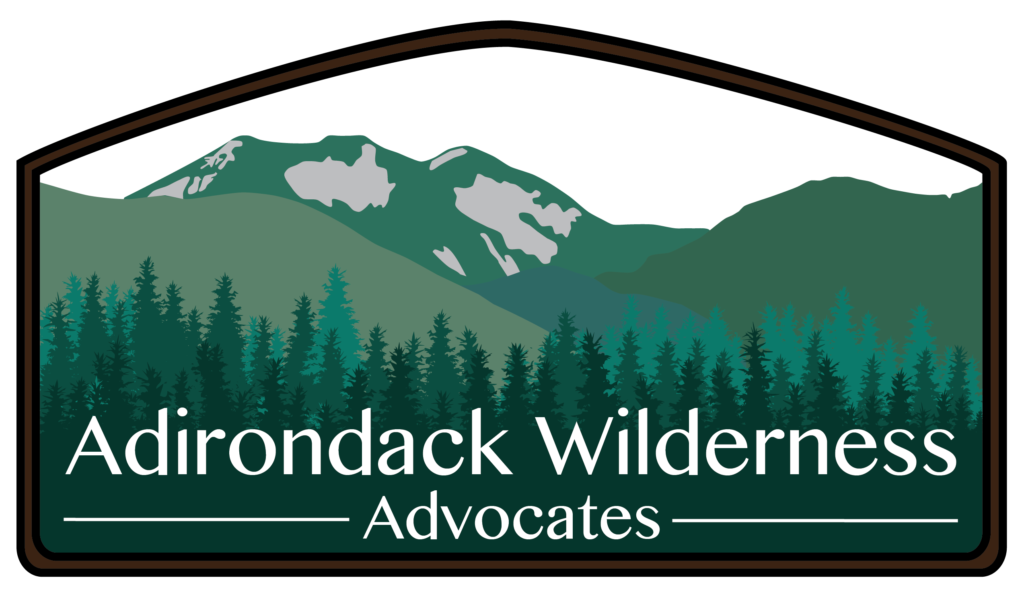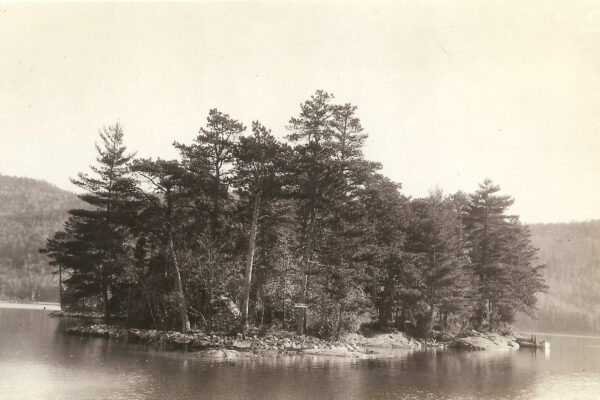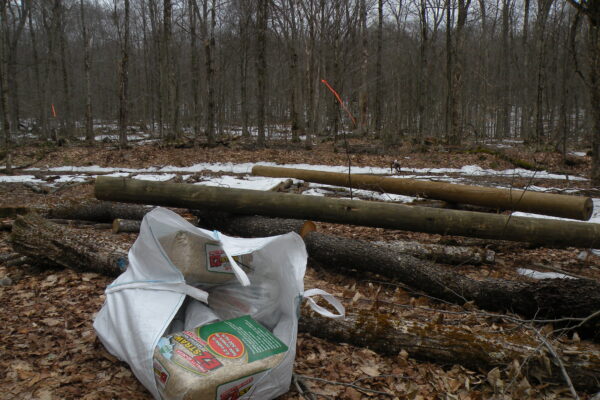If one looks back to the first years of the twentieth century, at Lake George, it is pretty obvious that an epic power struggle emerged between those who were eager to build roads and expand commercial operations at Ticonderoga, versus various far-sighted, preservation-minded individuals and organizations who wanted to keep the lake as peaceful and quiet as possible. Since this struggle has never gotten much attention from scholars, it might be worthwhile to investigate what happened when newspapers first began printing headlines, in 1908-1910, about problems with water levels due to the newest dam constructed by the International Paper Company, and its addition of eight-inch flashboards.
We have a fairly comprehensive set of documents to draw from, provided by the newspaper clippings and correspondence saved by one very conscientious activist, John Apperson, who wanted to learn all about the issues and problems of his day, and hoped to find solutions for every one of them. He understood the significance of saving these odds and ends, and scholars are now able to find out what he learned, more than one hundred years ago.
Most of his papers are stored in Schenectady, at the Kelly Adirondack Center, but many of them have been copied and transcribed (by yours truly, his great-niece), making it possible to share these excerpts here. In addition to this resource, I have also looked for insight and further details in some of the regional histories, by Frank Leonbruno, Bill Gates, and Tony Hall. So here are some questions, followed by passages I have found that will shed a little light on this early chapter of Lake George’s environmental history.
1. What do we know about the Lake George water levels in the eighteenth or nineteenth century, before the owners of the mills at Ticonderoga decided to extend the height of their dam, using flashboards?
According to Frank Leonbruno (Lake George Reflections: Island History and Lore, 1998), in thinking back to the eighteenth century, he noted that the water levels at Lake George must have been about two feet lower. He tells the story of Prison Island where a large group of French prisoners were held captive by the British during the French and Indian War, but who were able to escape, simply by wading through the water, and walking over to the nearest shore. Here is how Leonbruno described it:
During the first skirmish, in which Howe was killed, the British captured 148 French prisoners and brought them to Prison Island. According to local legend, the French, who were well acquainted with this part of the lake, knew that they could easily wade ashore from the island. During the night, when all was still, they quietly waded across the channel to the mainland, thus leaving the not-so-watchful English guard in command of a deserted island. It was from this escapade that the expression “taking French leave” originated. However, it must be remembered that many such stories about Lake George history are often rooted more in lore than in fact.
Then Leonbruno went on to say:
Nevertheless, there is no doubt that it would have been possible in those times to wade from the island to the shore. The water’s depth at that point today is waist high, according to Bob Rostetter of the DEC. No one knows the shallow waters of Lake George any better than Bob, who has been setting the buoys and navigation aids for DEC since 1979. But during the eighteenth century that water was even shallower. A man-made dam installed at the northern end of the lake earlier in this century has raised the lake’s level almost two feet. (139-140)

2. What do we know about the use of 8” flashboards at the top of the dam? How could they be responsible for raising the lake’s water levels by dozens of inches?
According to a report that Apperson obtained, in 1908, a well-respected scientist explained that, in Warrensburg, an 8” flashboard on the dam of the Hudson River caused the river to “set back” further upstream.
This was exactly what was happening at Lake George. This may not have come to the attention of the public right away, but by August of 1910, an editorial appeared in the Lake George Mirror, describing the problem:
Making a mill-dam of Lake George is, we believe, one of the chief assets of the International Paper Company’s plant at Ticonderoga. The company have [sic] claimed in various controversies that they do not manipulate the level of the waters of the lake, and in plausible argument call the attention of any interested to the fact that the top of their dam is much below the level of the lake. They do not concede what has become an established fact through expert testimony in the courts of the State – that the water in a stream will set back far above the level of the top of the retarding obstruction. And this is precisely what is being done at Ticonderoga – the setting back of the water by the means of brackets on their dam so that the retarding of the outlet of Lake George is manipulated until this whole body of water is nothing more or less than a huge mill-dam operated for the sole benefit of this concern. (August 5, 1910)

3. What do we know about the local organizations that took the lead in organizing shore owners in protecting Lake George?
The Bolton Improvement Association was formed through the leadership of many of Lake George’s most prominent landowners, including Mary Loines, William K. Bixby, George O. Knapp, George Foster Peabody, and George McAneny. They were concerned about many problems and objectives concerning the “welfare of Lake George,” as illustrated by this announcement sent out by the Bolton Improvement Association, in 1908:
September 16, 1908
The Bolton Improvement Association invites your attendance at a general conference of residents interested in the welfare of Lake George to be held at the Sagamore Hotel at twelve o’clock, noon, Wednesday, the 23rd instant, for the purpose of discussing the following subjects:
- The necessity of taking some steps to secure legislation at the next legislative session through which the forests of the shores of the Lake may be more effectively protected.
- The desirability of securing a restoration of the former post office name of Caldwell, so that the inconvenience arising from the use of the name “Lake George” as the designation of a single locality may be avoided.
- Such other matters, relating to the common interests of the Lake as may be presented.
As perhaps the most effective means of preserving forests, it has been suggested that the Legislature and the Governor be asked either to extend the lines of the “Adirondack Park” so as to include the lake, or to establish a separate “Lake George Park” on similar lines, within the limits of which the State would in future be at liberty to purchase lands for public reservation whenever such reservation may seem desirable.
Governor Hughes, who has been invited to address a meeting of another character to be held at the Sagamore the same day, has written that if he does come to the Lake he will speak at this conference also.
If you will extend this invitation to others of your locality who would be interested, the Bolton Association will greatly appreciate it. May I ask, also, that if you are able to attend, you will let me have a brief line to that effect, addressed to Bolton Landing.
Very truly yours,
George McAneny, President
In 1909, people were excited about the possibilities for a road over Tongue Mountain, the opening of the Lake George Club, and an upcoming celebration of the Champlain Tercentenary. Here is a clipping from June of 1909, from the New York Times.
At Lake George – Road over Tongue Mountain
Highway from Lake George to Bolton, and beyond…
At Lake George
Costly Improvements Being made in Transit and Terminal Facilities
Special to the NY Times – June 5, 1909
Lake George, June 5, – Someday – not far off – Lake George will be one of the most famous summer resorts in the world. That is a broad statement, but facts seem to warrant it. Lake George has been getting to be more popular every year.
…Through the efforts of Senator Emerson the last Legislature made it possible for the State Highway Commission to build a new macadam highway through the village to connect with the state roads already constructed between Lake George and Glens Falls, and Lake George and Bolton. The surveyors are now completing their work. Moreover, by private subscription, a large sum of money has been raised to build a road over Tongue Mountain on the west shore of the lake connecting Bolton Landing with Hague and Ticonderoga.
When these roads are completed a direct route will be afforded motorists from Albany to the upper Adirondacks.
…Lake George will have some of the glory incident to the Champlain tercentenary, as Vice President Silverman, Speaker Cannon, and possibly President Taft will be guests of Senator Emerson and visitors at the lake for a brief time on July 5, while the party is on route to Lake Champlain. …The trip will be made from Schenectady by automobiles.
Last summer the Lake George Country Club, composed of the prominent cottagers, was organized and a large tract of land was purchased near the Marion House. Ground was broken for a new clubhouse last Fall, and the building will be ready for occupancy in the course of a month, when a housewarming reception will be given.
George McAneny and the Bolton Improvement Association combined forces with another group, already known for its interest in fishing and water quality, the Lake George Fish and Game Association (LGA), and in August, 1909, they produced a comprehensive report covering all its objectives and interests, and describing the first meeting.
The Lake George Association was organized at a meeting of more than one hundred county and lake dwellers in August, 1909, and called for that purpose by George McAneny, as president of the Bolton Improvement Association, which had been active for several years in conservation work. Mr. McAneny first saw the need of a larger and more representative body. A second meeting was held in September, when the Lake George Fish and Game Association was amalgamated with the larger body, a constitution adopted, and Henry W. Hayden, the head of the game protective organization, made president of the new and combined body.
The other officers elected were: Spencer Trask, first vice-president; Gen. J. G. C. Lee, second vice president; R. B. Insley, secretary; George McAneny, president of the Borough of Manhattan, treasurer; Mr. Trask, shortly after the election, was killed in an accident on the New York Central while returning to New York.
…
Committees were appointed on fish and game, forest, waters, transportation, sanitation, and postal affairs, with the chairman of each named for his particular knowledge and experience along his respective line of work.
Many of the members as individuals had attempted the correction of some of the existing evils before the association was formed, and came into this organization with enthusiasm and delight over the work that lay before them.
John Apperson must have followed closely all these interesting developments, but he was not an owner of any property and thus was ineligible for membership in the LGA. However, he had already made quite a name for himself around Schenectady, as a promoter of all sorts of outdoor recreation, including skiing, skate sailing, winter camping, and excursions into the Adirondack Park. In fact, he had already made a commitment to spend every weekend for one year camping on the Dollar Islands and inviting other campers to join him in rip-rapping the shores.

We don’t know when he first heard about John Muir’s efforts to save Hetch-Hetchy from being flooded by a dam in Yosemite National Park, but he must have considered Muir an inspiration. He was also inspired by many of the “great and gracious” at Lake George, including George McAneny, Mary Loines, George Foster Peabody, George O. Knapp (up until 1922), and William K. Bixby, and they all supported him in various ways.
Just think about what they accomplished: the protection of over fifty islands in the Narrows, funding for a Lake George Park (used to purchase land on Tongue Mountain, Northwest Bay, Paradise Bay and the eastern shore), and a prototype for land trusts, by donating Dome Island to the Eastern Chapter of the Nature Conservancy in 1956 (the first such land gift with an endowment attached…ever).
And as for the problems concerning “Lake George: A Mill Pond,” one can read more about it soon in future installments on this topic, as we explore the letters from the archives during the fifteen years of litigation known as the Lake George Water Trespass Case. (Believe it or not, the Lake George Association decided to defend System Properties, the owners of the mill at Ticonderoga!)
In closing, here is another short excerpt from the meeting held by the LGA in 1910 describing their attitude about the controversy…
There is no desire on the part of the Lake George Association to inflict unnecessary hardship upon the pulp and paper mills of the Paper Trust, nor the other industries of this flourishing village, but the association will insist that the mills are not entitled to any more water than the natural flow of the lake, and if it cannot reach an amicable arrangement there is every indication of a lively fight between a great corporation and a band of influential and pubic spirited citizens.



